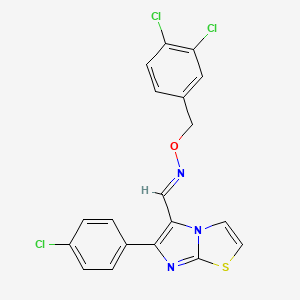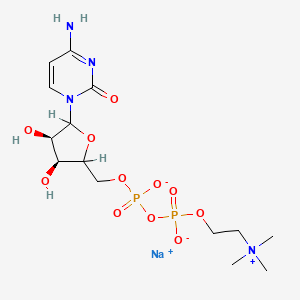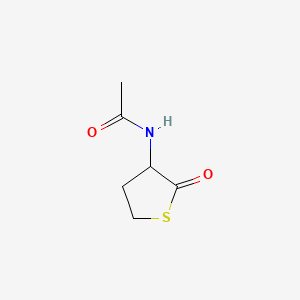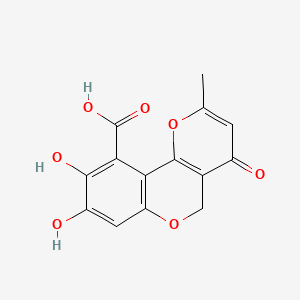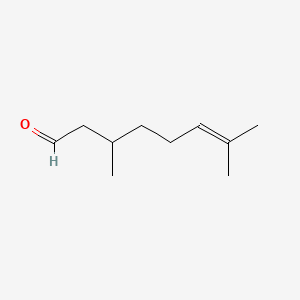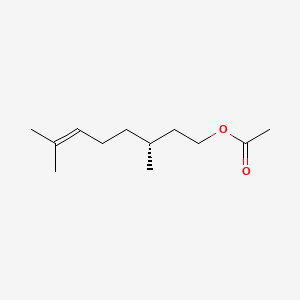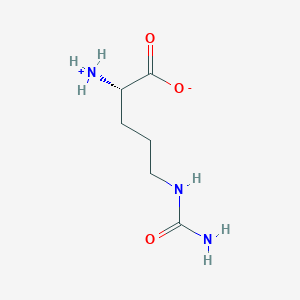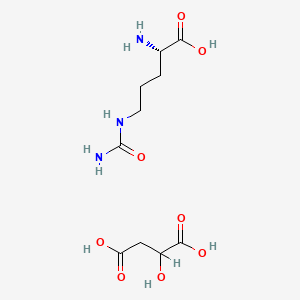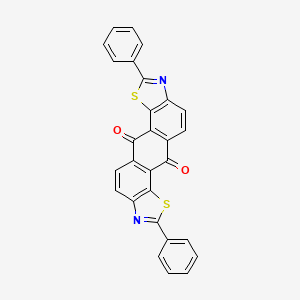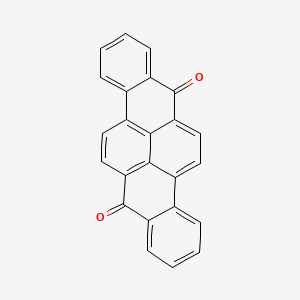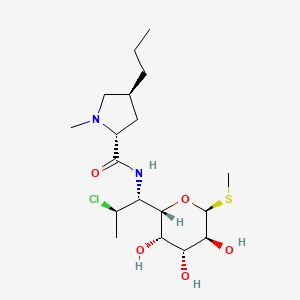
Clindamycine
Vue d'ensemble
Description
La clindamycine est un antibiotique de la famille des lincosamides utilisé pour traiter une variété d'infections bactériennes. Elle est particulièrement efficace contre les bactéries anaérobies et certaines bactéries Gram-positives, notamment les staphylocoques et les streptocoques. La this compound est couramment utilisée pour traiter des infections telles que l'ostéomyélite, la maladie inflammatoire pelvienne, l'angine streptococcique, la pneumonie et les infections cutanées . Elle est disponible sous diverses formes, notamment des capsules orales, des crèmes topiques et des solutions intraveineuses .
Mécanisme D'action
Target of Action
Clindamycin, a lincosamide antibiotic, primarily targets the 50s ribosomal subunit of bacteria . This subunit plays a crucial role in protein synthesis, making it an effective target for clindamycin .
Mode of Action
Clindamycin operates by inhibiting bacterial protein synthesis . It achieves this by binding to the 50s subunit of the bacterial ribosome, thus preventing the elongation of the peptide chain during translation . This disruption of protein synthesis interferes with the transpeptidation reaction, thereby inhibiting early chain elongation .
Biochemical Pathways
By disrupting bacterial protein synthesis, clindamycin causes changes in the cell wall surface, which decreases adherence of bacteria to host cells and increases intracellular killing of organisms . The drug also exerts an extended postantibiotic effect against some strains of bacteria, which may be attributed to the persistence of the drug at the ribosomal binding site .
Pharmacokinetics
Clindamycin exhibits high bioavailability, with approximately 90% of an oral dose rapidly absorbed from the gastrointestinal tract . Peak serum concentrations are attained within 45 minutes . Clindamycin is metabolized in the liver and excreted via the bile duct and kidneys .
Result of Action
The primary result of clindamycin’s action is the effective treatment of a variety of serious infections due to susceptible microorganisms . These include anaerobic bacteria as well as gram-positive cocci and bacilli . Clindamycin is also used for antimicrobial prophylaxis against Viridans group streptococcal infections in susceptible patients undergoing oral, dental, or upper respiratory surgery .
Action Environment
The action of clindamycin can be influenced by environmental factors such as the presence of other drugs. For instance, chloramphenicol and macrolides such as erythromycin, clarithromycin, and azithromycin also act at the 50s ribosomal subunit and may compete for binding at this site . Furthermore, the efficacy of clindamycin can be affected by the disease state and the patient’s immune response .
Applications De Recherche Scientifique
La clindamycine a un large éventail d'applications en recherche scientifique :
Chimie : Elle est utilisée comme composé modèle dans l'étude de la synthèse et de la modification des antibiotiques.
Biologie : La this compound est utilisée pour étudier la synthèse des protéines bactériennes et les mécanismes de résistance.
Médecine : Elle est largement utilisée pour traiter les infections bactériennes, y compris celles causées par le Staphylococcus aureus résistant à la méthicilline (SARM) et les bactéries anaérobies
5. Mécanisme d'action
La this compound agit en se liant à la sous-unité ribosomique 50S des bactéries, inhibant la synthèse des protéines. Cette action empêche l'élongation de la chaîne peptidique pendant la traduction, stoppant efficacement la croissance bactérienne . La this compound cible le ribosome bactérien, perturbant la réaction de transpeptidation et inhibant l'élongation précoce de la chaîne .
Analyse Biochimique
Biochemical Properties
Clindamycin works primarily by binding to the 50S ribosomal subunit of bacteria . This agent disrupts protein synthesis by interfering with the transpeptidation reaction, which thereby inhibits early chain elongation . By disrupting bacterial protein synthesis, clindamycin causes changes in the cell wall surface, which decreases adherence of bacteria to host cells and increases intracellular killing of organisms .
Cellular Effects
Clindamycin achieves high intracellular levels in phagocytic cells . By disrupting bacterial protein synthesis, clindamycin causes changes in the cell wall surface, which decreases adherence of bacteria to host cells and increases intracellular killing of organisms .
Molecular Mechanism
Clindamycin inhibits bacterial protein synthesis by binding to 23S RNA of the 50S subunit of the bacterial ribosome . It impedes both the assembly of the ribosome and the translation process . The molecular mechanism through which this occurs is thought to be due to clindamycin’s three-dimensional structure, which closely resembles the 3’-ends of L-Pro-Met-tRNA and deacylated-tRNA during the peptide elongation cycle .
Temporal Effects in Laboratory Settings
Clindamycin exerts an extended postantibiotic effect against some strains of bacteria, which may be attributed to persistence of the drug at the ribosomal binding site .
Dosage Effects in Animal Models
In veterinary medicine, clindamycin is used at a dosage of 10-15 mg/kg, administered orally or intravenously every 12-24 hours . There are rarely reported cases of overdosage since clindamycin is well tolerated even at high dosages .
Metabolic Pathways
Clindamycin undergoes hepatic metabolism mediated primarily by CYP3A4 and, to a lesser extent, CYP3A5 . Two inactive metabolites have been identified - an oxidative metabolite, clindamycin sulfoxide, and an N-demethylated metabolite, N-desmethylclindamycin .
Transport and Distribution
Clindamycin is widely distributed in the body, including into bone, but does not distribute into cerebrospinal fluid . The volume of distribution has been variably estimated between 43-74 L .
Subcellular Localization
The primary targets of clindamycin, the 50S ribosomal subunits, are located in the cytoplasm of the bacterial cell . Therefore, the subcellular localization of clindamycin would be within the bacterial cytoplasm where it can exert its effects .
Méthodes De Préparation
La clindamycine est synthétisée à partir de la lincomycine, un antibiotique naturel. La synthèse implique la chloration de la lincomycine pour remplacer le groupe hydroxyle en position 7 par un atome de chlore . Le processus comprend plusieurs étapes :
Application d'un groupe protecteur silicium : La lincomycine est d'abord protégée à l'aide d'un groupe silicium.
Déprotection sélective : La lincomycine protégée subit une déprotection sélective.
Réaction de substitution de Mitsunobu : La lincomycine déprotégée est soumise à une réaction de substitution de Mitsunobu.
Réaction d'hydrolyse : Le produit est ensuite hydrolysé pour obtenir la 7-épimé lincomycine.
Réaction de chloration : Enfin, la 7-épimé lincomycine est chlorée pour produire la this compound.
La production industrielle de chlorhydrate de this compound implique des étapes de chloration, d'hydrolyse, d'extraction et de concentration pour obtenir la forme alcaline libre, suivie de la formation du sel et de la désalcoolisation pour obtenir le chlorhydrate de this compound .
Analyse Des Réactions Chimiques
La clindamycine subit diverses réactions chimiques, notamment :
Oxydation : La this compound peut être oxydée pour former des métabolites sulfoxyde et N-déméthylés.
Réduction : Les réactions de réduction sont moins fréquentes mais peuvent se produire dans des conditions spécifiques.
Substitution : La réaction de substitution de Mitsunobu est une étape clé de sa synthèse.
Les réactifs courants utilisés dans ces réactions comprennent les agents chlorants, les agents oxydants et les agents réducteurs. Les principaux produits formés à partir de ces réactions sont le chlorhydrate de this compound et ses métabolites .
Comparaison Avec Des Composés Similaires
La clindamycine est souvent comparée à d'autres antibiotiques, tels que :
Lincomycine : La this compound est un dérivé chloré de la lincomycine avec des propriétés améliorées.
Amoxicilline : Un antibiotique de type pénicilline utilisé pour des infections similaires mais avec un mécanisme d'action différent.
Doxycycline : Un antibiotique tétracycline avec un spectre d'activité plus large
La this compound est unique en raison de son efficacité élevée contre les bactéries anaérobies et de sa capacité à pénétrer les os et les abcès, ce qui la rend particulièrement utile pour le traitement de l'ostéomyélite et d'autres infections profondes .
Propriétés
IUPAC Name |
(2S,4R)-N-[(1S,2S)-2-chloro-1-[(2R,3R,4S,5R,6R)-3,4,5-trihydroxy-6-methylsulfanyloxan-2-yl]propyl]-1-methyl-4-propylpyrrolidine-2-carboxamide | |
|---|---|---|
| Source | PubChem | |
| URL | https://pubchem.ncbi.nlm.nih.gov | |
| Description | Data deposited in or computed by PubChem | |
InChI |
InChI=1S/C18H33ClN2O5S/c1-5-6-10-7-11(21(3)8-10)17(25)20-12(9(2)19)16-14(23)13(22)15(24)18(26-16)27-4/h9-16,18,22-24H,5-8H2,1-4H3,(H,20,25)/t9-,10+,11-,12+,13-,14+,15+,16+,18+/m0/s1 | |
| Source | PubChem | |
| URL | https://pubchem.ncbi.nlm.nih.gov | |
| Description | Data deposited in or computed by PubChem | |
InChI Key |
KDLRVYVGXIQJDK-AWPVFWJPSA-N | |
| Source | PubChem | |
| URL | https://pubchem.ncbi.nlm.nih.gov | |
| Description | Data deposited in or computed by PubChem | |
Canonical SMILES |
CCCC1CC(N(C1)C)C(=O)NC(C2C(C(C(C(O2)SC)O)O)O)C(C)Cl | |
| Source | PubChem | |
| URL | https://pubchem.ncbi.nlm.nih.gov | |
| Description | Data deposited in or computed by PubChem | |
Isomeric SMILES |
CCC[C@@H]1C[C@H](N(C1)C)C(=O)N[C@@H]([C@@H]2[C@@H]([C@@H]([C@H]([C@H](O2)SC)O)O)O)[C@H](C)Cl | |
| Source | PubChem | |
| URL | https://pubchem.ncbi.nlm.nih.gov | |
| Description | Data deposited in or computed by PubChem | |
Molecular Formula |
C18H33ClN2O5S | |
| Source | PubChem | |
| URL | https://pubchem.ncbi.nlm.nih.gov | |
| Description | Data deposited in or computed by PubChem | |
Related CAS |
21462-39-5 (mono-hydrochloride), 58207-19-5 (mono-HCl, mono-hydrate) | |
| Record name | Clindamycin [USAN:INN:BAN] | |
| Source | ChemIDplus | |
| URL | https://pubchem.ncbi.nlm.nih.gov/substance/?source=chemidplus&sourceid=0018323449 | |
| Description | ChemIDplus is a free, web search system that provides access to the structure and nomenclature authority files used for the identification of chemical substances cited in National Library of Medicine (NLM) databases, including the TOXNET system. | |
DSSTOX Substance ID |
DTXSID2022836 | |
| Record name | Clindamycin | |
| Source | EPA DSSTox | |
| URL | https://comptox.epa.gov/dashboard/DTXSID2022836 | |
| Description | DSSTox provides a high quality public chemistry resource for supporting improved predictive toxicology. | |
Molecular Weight |
425.0 g/mol | |
| Source | PubChem | |
| URL | https://pubchem.ncbi.nlm.nih.gov | |
| Description | Data deposited in or computed by PubChem | |
Mechanism of Action |
Clindamycin may be bacteriostatic or bactericidal in action, depending on the concentration of the drug attained at the site of infection and the susceptibility of the infecting organism. Clindamycin palmitate hydrochloride and clindamycin phosphate are inactive until hydrolyzed to free clindamycin. This hydrolysis occurs rapidly in vivo. Clindamycin appears to inhibit protein synthesis in susceptible organisms by binding to 50S ribosomal subunits; the primary effect is inhibition of peptide bond formation. The site of action appears to be the same as that of erythromycin, chloramphenicol, and lincomycin., Clindamycin binds exclusively to the 50S subunit of bacterial ribosomes and suppresses protein synthesis., ... Clindamycin is not a substrate for macrolide efflux pumps, and strains that are resistant to macrolides by this mechanism are susceptible to clindamycin. | |
| Record name | CLINDAMYCIN | |
| Source | Hazardous Substances Data Bank (HSDB) | |
| URL | https://pubchem.ncbi.nlm.nih.gov/source/hsdb/3037 | |
| Description | The Hazardous Substances Data Bank (HSDB) is a toxicology database that focuses on the toxicology of potentially hazardous chemicals. It provides information on human exposure, industrial hygiene, emergency handling procedures, environmental fate, regulatory requirements, nanomaterials, and related areas. The information in HSDB has been assessed by a Scientific Review Panel. | |
Color/Form |
Yellow, amorphous solid | |
CAS No. |
18323-44-9 | |
| Record name | Clindamycin | |
| Source | CAS Common Chemistry | |
| URL | https://commonchemistry.cas.org/detail?cas_rn=18323-44-9 | |
| Description | CAS Common Chemistry is an open community resource for accessing chemical information. Nearly 500,000 chemical substances from CAS REGISTRY cover areas of community interest, including common and frequently regulated chemicals, and those relevant to high school and undergraduate chemistry classes. This chemical information, curated by our expert scientists, is provided in alignment with our mission as a division of the American Chemical Society. | |
| Explanation | The data from CAS Common Chemistry is provided under a CC-BY-NC 4.0 license, unless otherwise stated. | |
| Record name | Clindamycin [USAN:INN:BAN] | |
| Source | ChemIDplus | |
| URL | https://pubchem.ncbi.nlm.nih.gov/substance/?source=chemidplus&sourceid=0018323449 | |
| Description | ChemIDplus is a free, web search system that provides access to the structure and nomenclature authority files used for the identification of chemical substances cited in National Library of Medicine (NLM) databases, including the TOXNET system. | |
| Record name | Clindamycin | |
| Source | EPA DSSTox | |
| URL | https://comptox.epa.gov/dashboard/DTXSID2022836 | |
| Description | DSSTox provides a high quality public chemistry resource for supporting improved predictive toxicology. | |
| Record name | Clindamycin | |
| Source | European Chemicals Agency (ECHA) | |
| URL | https://echa.europa.eu/substance-information/-/substanceinfo/100.038.357 | |
| Description | The European Chemicals Agency (ECHA) is an agency of the European Union which is the driving force among regulatory authorities in implementing the EU's groundbreaking chemicals legislation for the benefit of human health and the environment as well as for innovation and competitiveness. | |
| Explanation | Use of the information, documents and data from the ECHA website is subject to the terms and conditions of this Legal Notice, and subject to other binding limitations provided for under applicable law, the information, documents and data made available on the ECHA website may be reproduced, distributed and/or used, totally or in part, for non-commercial purposes provided that ECHA is acknowledged as the source: "Source: European Chemicals Agency, http://echa.europa.eu/". Such acknowledgement must be included in each copy of the material. ECHA permits and encourages organisations and individuals to create links to the ECHA website under the following cumulative conditions: Links can only be made to webpages that provide a link to the Legal Notice page. | |
| Record name | CLINDAMYCIN | |
| Source | FDA Global Substance Registration System (GSRS) | |
| URL | https://gsrs.ncats.nih.gov/ginas/app/beta/substances/3U02EL437C | |
| Description | The FDA Global Substance Registration System (GSRS) enables the efficient and accurate exchange of information on what substances are in regulated products. Instead of relying on names, which vary across regulatory domains, countries, and regions, the GSRS knowledge base makes it possible for substances to be defined by standardized, scientific descriptions. | |
| Explanation | Unless otherwise noted, the contents of the FDA website (www.fda.gov), both text and graphics, are not copyrighted. They are in the public domain and may be republished, reprinted and otherwise used freely by anyone without the need to obtain permission from FDA. Credit to the U.S. Food and Drug Administration as the source is appreciated but not required. | |
| Record name | CLINDAMYCIN | |
| Source | Hazardous Substances Data Bank (HSDB) | |
| URL | https://pubchem.ncbi.nlm.nih.gov/source/hsdb/3037 | |
| Description | The Hazardous Substances Data Bank (HSDB) is a toxicology database that focuses on the toxicology of potentially hazardous chemicals. It provides information on human exposure, industrial hygiene, emergency handling procedures, environmental fate, regulatory requirements, nanomaterials, and related areas. The information in HSDB has been assessed by a Scientific Review Panel. | |
Retrosynthesis Analysis
AI-Powered Synthesis Planning: Our tool employs the Template_relevance Pistachio, Template_relevance Bkms_metabolic, Template_relevance Pistachio_ringbreaker, Template_relevance Reaxys, Template_relevance Reaxys_biocatalysis model, leveraging a vast database of chemical reactions to predict feasible synthetic routes.
One-Step Synthesis Focus: Specifically designed for one-step synthesis, it provides concise and direct routes for your target compounds, streamlining the synthesis process.
Accurate Predictions: Utilizing the extensive PISTACHIO, BKMS_METABOLIC, PISTACHIO_RINGBREAKER, REAXYS, REAXYS_BIOCATALYSIS database, our tool offers high-accuracy predictions, reflecting the latest in chemical research and data.
Strategy Settings
| Precursor scoring | Relevance Heuristic |
|---|---|
| Min. plausibility | 0.01 |
| Model | Template_relevance |
| Template Set | Pistachio/Bkms_metabolic/Pistachio_ringbreaker/Reaxys/Reaxys_biocatalysis |
| Top-N result to add to graph | 6 |
Feasible Synthetic Routes
Q1: How does Clindamycin exert its antibacterial effect?
A1: Clindamycin inhibits bacterial protein synthesis by binding to the 50S ribosomal subunit, specifically at the center of the peptidyl transferase center. [, , ] This binding prevents peptide bond formation and disrupts the translocation process, ultimately halting protein synthesis and leading to bacterial growth inhibition or death. [, ]
Q2: Does Clindamycin possess any anti-inflammatory properties?
A3: Yes, in addition to its antibacterial action, Clindamycin also exhibits anti-inflammatory effects. [] It has been shown to reduce inflammation associated with acne by influencing inflammatory pathways and potentially inhibiting neutrophil chemotaxis. []
Q3: What is the molecular formula and weight of Clindamycin?
A4: The molecular formula of Clindamycin is C18H33ClN2O5S, and its molecular weight is 424.98 g/mol. []
Q4: How stable are intravenous admixtures containing Clindamycin?
A6: Intravenous admixtures of Clindamycin phosphate with aztreonam at specific concentrations have demonstrated stability for at least 48 hours at 22-23°C and for at least seven days at 4°C. []
Q5: How do structural modifications of Clindamycin affect its activity?
A7: Research shows that the presence of the 7(S)-chloro-7-deoxy function in Clindamycin is crucial for its potent antibacterial activity. [] Alterations to this specific structural feature can significantly impact Clindamycin's ability to bind to the bacterial ribosome and inhibit protein synthesis. []
Q6: What are some strategies to enhance Clindamycin's delivery to target tissues?
A8: One approach involves encapsulating Clindamycin phosphate into transfersomal nanoparticles. [] These nanoparticles have been shown to improve the drug's transdermal delivery and penetration into deeper skin layers, potentially enhancing its efficacy for treating skin infections. []
Q7: Can bile acids improve Clindamycin's permeation through the skin?
A9: Yes, incorporating bile acids like cholic acid into Clindamycin hydrogel formulations has been shown to enhance the drug's release rate and permeation through cellulose membranes in vitro. [] This finding suggests the potential for bile acids to improve Clindamycin's penetration through the skin barrier. []
Q8: How is Clindamycin absorbed and distributed in the body?
A10: Clindamycin is rapidly absorbed after oral administration, reaching peak plasma concentrations in about 0.5 hours. [] It demonstrates good tissue penetration and is known to accumulate in phagocytes, which can be beneficial for treating intracellular infections. [, ]
Q9: Are there differences in bioavailability between Clindamycin phosphate ester tablets and Clindamycin hydrochloride capsules?
A11: Studies have shown bioequivalence between orally disintegrating Clindamycin phosphate ester tablets and Clindamycin hydrochloride capsules. [] This suggests that both formulations provide comparable amounts of Clindamycin in the bloodstream. []
Q10: What are some animal models used to study Clindamycin's efficacy?
A12: A murine model has been utilized to investigate Clindamycin's efficacy in treating community-acquired methicillin-resistant Staphylococcus aureus (CA-MRSA) pneumonia. [] Results indicated that Clindamycin effectively reduced bacterial load, improved survival rates, and mitigated lung damage in infected mice. []
Q11: Has Clindamycin been compared to other antibiotics in clinical trials?
A13: Yes, several clinical trials have compared Clindamycin to other antibiotics for treating various infections. For instance, a study on bacterial vaginosis found comparable cure rates between oral metronidazole, metronidazole vaginal gel, and Clindamycin vaginal cream. [] Another trial showed similar efficacy between Clindamycin, amoxicillin, and erythromycin for treating Chlamydia trachomatis in pregnant women. []
Q12: What is the significance of inducible clindamycin resistance in Staphylococcal infections?
A14: Inducible clindamycin resistance (ICR) is a concern in Staphylococcal infections because routine susceptibility tests may misinterpret resistant strains as susceptible. [, , , , , , , ] This misinterpretation can lead to therapeutic failure if Clindamycin is chosen for treatment. [, , , , , , , ] Performing a D-test is crucial to accurately identify ICR and guide appropriate antibiotic selection. [, , , , , , , ]
Q13: What is the most common mechanism behind clindamycin resistance in Staphylococci?
A15: The most prevalent mechanism is through the erm gene, which encodes for ribosomal methylases. [, , , , , , , ] These methylases modify the bacterial ribosome, preventing Clindamycin binding and rendering the bacteria resistant. [, , , , , , , ]
Q14: How does prior clindamycin exposure affect the susceptibility of Clostridium difficile?
A16: Studies indicate that prior clindamycin use is significantly associated with Clostridium difficile-associated diarrhea (CDAD) caused by isolates resistant to clindamycin, erythromycin, and trovafloxacin. [] This association highlights the potential risk of selecting for resistant C. difficile strains following clindamycin exposure. []
Q15: What analytical methods are commonly used to quantify Clindamycin?
A17: High-performance liquid chromatography (HPLC) coupled with UV detection is a widely used method for quantifying Clindamycin in various matrices. [, , ] UPLC-MS (Ultra Performance Liquid Chromatography-Mass Spectrometry) is another powerful technique used to detect and quantify Clindamycin and its related substances, even at low concentrations. []
Q16: How can researchers ensure the accuracy and reliability of their analytical methods for Clindamycin?
A18: Rigorous analytical method validation is essential. This process involves assessing parameters such as accuracy, precision, specificity, linearity, range, limit of detection, limit of quantitation, robustness, and system suitability. [] Validated methods ensure reliable and accurate data for Clindamycin analysis. []
Avertissement et informations sur les produits de recherche in vitro
Veuillez noter que tous les articles et informations sur les produits présentés sur BenchChem sont destinés uniquement à des fins informatives. Les produits disponibles à l'achat sur BenchChem sont spécifiquement conçus pour des études in vitro, qui sont réalisées en dehors des organismes vivants. Les études in vitro, dérivées du terme latin "in verre", impliquent des expériences réalisées dans des environnements de laboratoire contrôlés à l'aide de cellules ou de tissus. Il est important de noter que ces produits ne sont pas classés comme médicaments et n'ont pas reçu l'approbation de la FDA pour la prévention, le traitement ou la guérison de toute condition médicale, affection ou maladie. Nous devons souligner que toute forme d'introduction corporelle de ces produits chez les humains ou les animaux est strictement interdite par la loi. Il est essentiel de respecter ces directives pour assurer la conformité aux normes légales et éthiques en matière de recherche et d'expérimentation.


